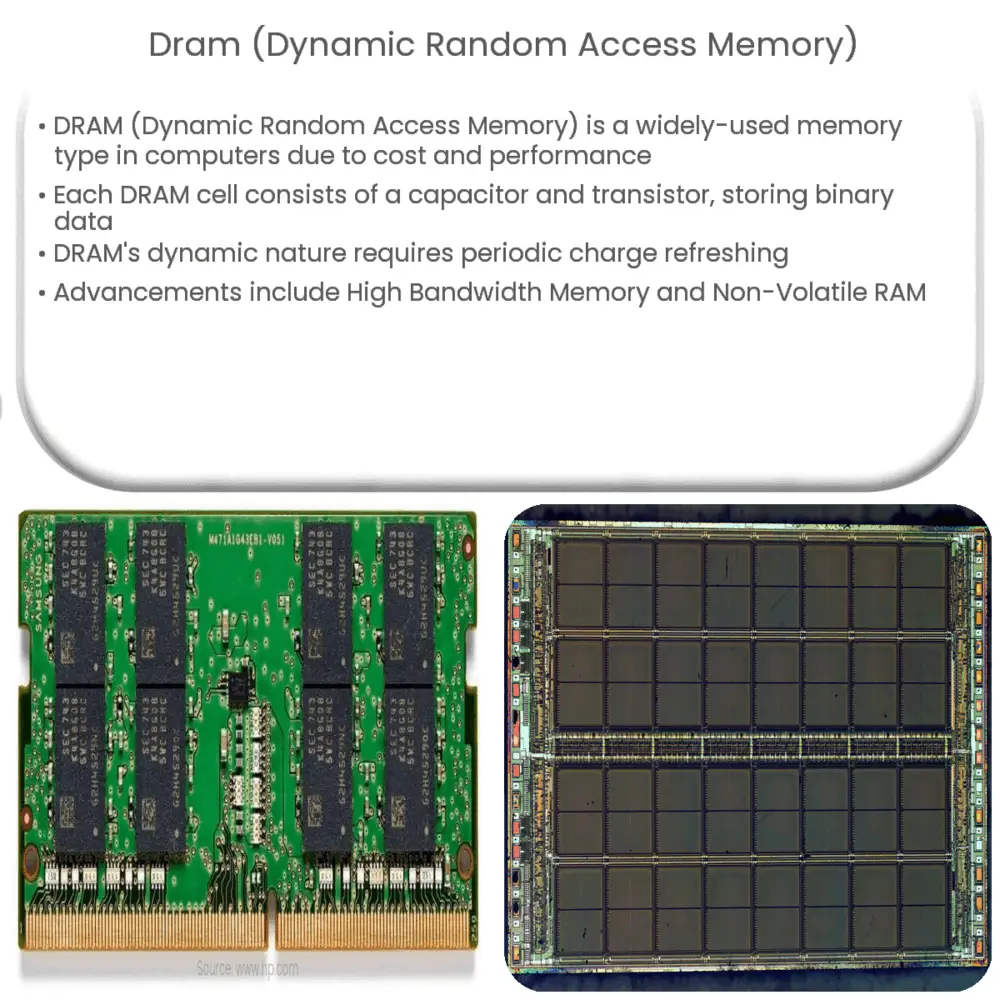Explore the world of DRAM (Dynamic Random Access Memory), its working principle, types, impact on computer performance, and recent advancements.

Introduction to DRAM
Dynamic Random Access Memory (DRAM) is a type of random access semiconductor memory that stores each bit of data in a memory cell consisting of a tiny capacitor and a transistor. This is the most widely used type of memory in computer systems due to its relatively low cost and excellent performance characteristics.
Working Principle of DRAM
At a fundamental level, each cell in a DRAM chip is composed of a transistor and a capacitor. These components form the memory cell, which is the smallest unit of data storage within the chip. Data is written to the cell by charging or discharging the capacitor, which represents a binary ‘1’ or ‘0’ respectively. The transistor acts as a switch that controls the charging and discharging of the capacitor.
However, there is a crucial aspect that sets DRAM apart from other types of RAM: the capacitors within the memory cells leak charge over time. This leads to the primary characteristic of DRAM – its dynamic nature. If the charge on the capacitors is not periodically refreshed, the information stored would eventually be lost. This is why it is referred to as ‘dynamic’. The need for refreshing is both a key feature and a significant limitation of DRAM.
Types of DRAM
- SDRAM (Synchronous DRAM): SDRAM synchronizes itself with the clock speed that the computer is configured for, which maximizes the number of times it can be accessed per second.
- DDR SDRAM (Double Data Rate Synchronous DRAM): DDR SDRAM is a specific class of SDRAM that achieves greater bandwidth by transferring data on both the rising and falling edges of the clock signal.
There are multiple iterations of DDR SDRAM, including DDR2, DDR3, and DDR4, each providing greater performance and power efficiency improvements.
The Role of DRAM in Computers
DRAM plays an essential role in computers by providing the ‘working’ memory that the CPU uses to execute commands. The speed and performance of the computer are significantly influenced by the amount and performance of the DRAM installed.
Understanding DRAM is vital for anyone interested in computer hardware, as it plays a crucial role in the function and performance of computers and many other types of digital devices.
DRAM and its Impact on Computer Performance
DRAM has a direct impact on the performance and efficiency of a computer. When a computer has more DRAM, it is capable of handling more applications simultaneously, increasing its multitasking capabilities. Furthermore, the performance of certain types of software, particularly games and other graphically intensive applications, can be significantly improved with more DRAM.
The speed of the DRAM also plays a significant role. Faster DRAM can process data more quickly, resulting in a smoother and more responsive computing experience. Each successive generation of DDR SDRAM has improved upon the data rate and efficiency of the previous one, which continues to drive advances in computing performance.
Advancements in DRAM Technology
Over the years, there have been significant advances in DRAM technology. One of the latest advancements is the development of High Bandwidth Memory (HBM), a type of memory that stacks DRAM chips vertically to achieve a much higher data transfer rate compared to traditional DRAM.
Another important advancement is the advent of Non-Volatile RAM (NVRAM), which maintains stored data even when the power is turned off. This contrasts with traditional DRAM, which is volatile and loses stored data when power is lost. This new technology can significantly reduce startup times and enhance system reliability.
Conclusion
In conclusion, Dynamic Random Access Memory (DRAM) is a critical component of modern computers. Its evolution over the years has been fundamental to the exponential increase in computing power we have witnessed. As it continues to evolve, we can expect even greater performance and efficiency gains, opening up new possibilities for computing and digital technology.
Whether you are a computer enthusiast, a software developer, or simply someone interested in understanding how your digital devices work, gaining a deeper understanding of DRAM and its importance can provide valuable insights into the fascinating world of computer hardware.

